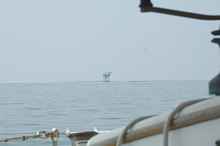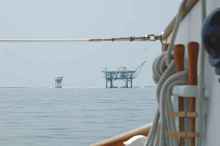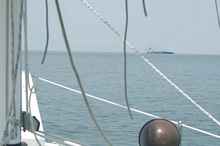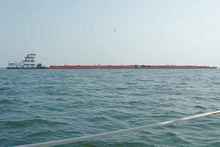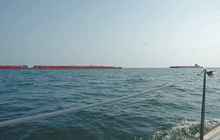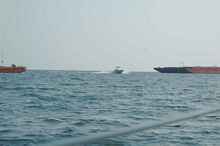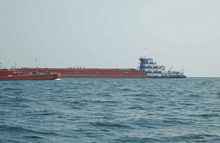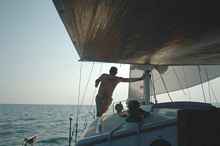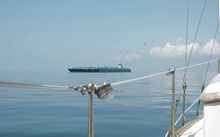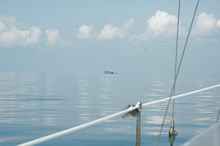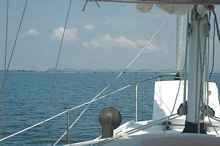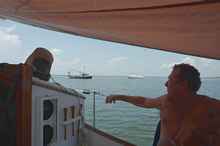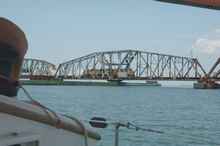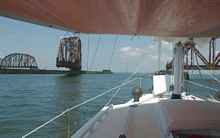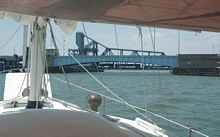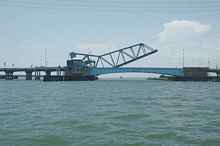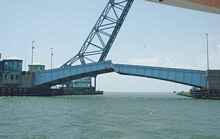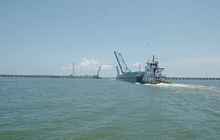
 Custom Search
|
|
| sails |
| plans |
| epoxy |
| rope/line |
| hardware |
| canoe/Kayak |
| sailmaking |
| materials |
| models |
| media |
| tools |
| gear |
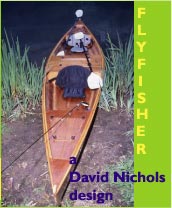 |
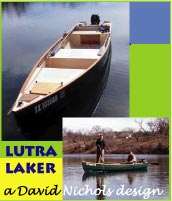 |
| join |
| home |
| indexes |
| classifieds |
| calendar |
| archives |
| about |
| links |
| Join Duckworks Get free newsletter Comment on articles CLICK HERE |
|
|
| Valora's Log |
by David Nichols - Austin, Texas - USA West again and the Big Easy |
 |
We drug bottom leaving the marina even though we left at high tide. And we learned that even though Mississippi Sound is a big body of water but it still required vigilance. We managed to touch bottom just after we passed under the bridge that goes to Dauphin Island in Pass Aux Herons and Channel Aux Herons. After marker "40" there are no more spoil banks on the side of the ICW and the sound opens up to 10 to 14 feet of water. But there were plenty of platforms and obstructions that required our attention at the helm.
Also barge traffic was on the increase. We thought we might have to delay passing under the bridge because of a barge on our stern but the barge was headed to Mobile. But everywhere we looked there seemed to be a barge.
And what we absolutely did not want to do was get caught sandwiched between two barges.
This power boater took a big chance by passing under the bows of these barges. Had the boat lost power in front of either barge it would have been a disaster for boat and crew. Neither of the barges would have been able to stop or change course to avoid the disabled boat. The Sound was easily deep enough for the boat to pass to the stern of either barge and that makes the power boater's choice harder to understand.
I was more than happy to give them a great deal of clearance. Being run over by a large barge can ruin your whole day. The depth of the sound also gave us an opportunity to motor sail instead of just push along with the diesel.
The breeze didn't last long and we were back under power alone as we slid by the never ending stream of barges.
The Sound became so flat that the horizon disappeared into the sky as we motored toward Lake Borgne, the Rigolets and New Orleans.
We had decided to take the Rigolets (pronounced Rig-o-lay) into Lake Pontchartrain because this route would have far less barge traffic, which was getting quite heavy the closer we got to New Orleans. There are several bridges that cross the Rigolets, and unlike some bridge tenders, the tenders on the Rigolets expect you to know what to do. Bridges on the ICW monitor VHF channel 9 or 13 and the Rigolets bridges monitor channel 13. The first bridge is a rail road swing bridge (the Rigolet railroad bridge) and we called when we were about 400 yards from the bridge. I found the tenders don't like it if you call too soon as they want to keep the bridge open for the shortest time possible. I waited for a response and after a minute or so called again. This time the tender told me there were three trains that had to cross and to be patient.
So we slowly circled with several other boats as Gene kept an eye out. Circling with other boats was the norm for almost every bridge we went under on the trip.
Finally the last train crossed the bridge and it slowly swung open.
I also found the tenders like for you start moving toward the bridge before it's fully open. There were times when I felt we cut it bit close particularly with the draw bridges. With the swing bridge to our stern we were in the Rigolets channel. This is wide and deep, it is an old channel for the Mississippi, and had zero channel markers. In daylight and with the GPS it's no problem but at night there is no way I would try and navigate the Rigolets. Up closer to Lake Pontchartrain there are some markers and then we came to the Highway 11 draw bride and a bascule bridge. This time I waited until we were very close to call Highway 11 Bridge on channel 13. This tender didn't respond at all but I could see a train approaching the bridge. Like the swing bridge it was a long wait circling because of the train.
The bascule bridge opened first followed by the draw bridge. I noticed that a barge was approaching from the other direction and that made the timing a little tricky. We certainly didn't want to tie at the bridges and the tender wasn't going to leave the bridges up for an extended period.
So as soon as we there was enough space for Valora's mast to clear the draw bridge gap we made a dash through. Well, Valora doesn't really dash but we were making all possible haste. As soon as we were clear I moved over and gave the barge lots of room.
I doubt that there would have been enough room for Valora and this big boy if we had tied at the bridge. David's plans are in the Duckworks Store Click Here for a List of Articles and Columns by David Nichols |
